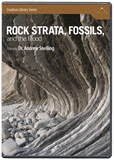
A Classic Tillite Reclassified as a Submarine Debris Flow
Originally published in Journal of Creation 11, no 1 (April 1997): 7.
Tillites, assumed to be the lithified equivalents of glacial till (rubble), are often found in the strata of the Earth. Hence, uniformitarian scientists postulate a number of long-lasting pre-Pleistocene ice ages, the Late Palaeozoic ‘ice age’ in southern Africa being the most notable. Many glacial-like diagnostic features also are associated with these tillites. However, Schermerhorn questioned the conclusion that many of these tillites, mainly from the Late Precambrian, were caused by ancient glaciation, pointing out that practically all the claimed diagnostic properties can be duplicated by mass flow and other processes.1
One of the classical Late Pre-cambrian tillites is the Bigganjargga tillite of northern Norway. It is even called Reusch’s moraine. The tillite overlies a striated pavement in which two striae directions, a sharp NW–SE set overprinting a faint E–W set, were embossed on the sandstone below. Two subparallel sets of striae are supposedly diagnostic of glaciation. One author claimed to have observed striated and faceted clasts within the tillite. The top layer of the tillite is composed of thin beds containing clasts larger than the thickness of the bedding, reminiscent of dropstone varvites. The above three characteristics of the Bigganjargga tillite are the main diagnostic features for an ancient ice age.2 Thus, most geologists accepted without question that the tillite was a remnant of the Late Precambrian ‘ice age’.3,4,5 However, a few geologists did question whether the tillite was really glaciogenic or else a mudflow deposit.6
Recently, a more in-depth analysis has indicated that this classical tillite is very likely a submarine debris flow.7 The striated pavement was found to have been made by rocks sliding along soft sandstone, because a few clasts are embedded in the sandstone. Moreover, clast imprints on the sandstone have the same random spacing as in the ‘tillite’ above. There are other soft-sediment deformation features. The sandstone had been assumed lithified and dated 150 million years older than the tillite. The authors now suggest this time gap is not real.
The matrix and clasts in the ‘tillite’ are rounded with the fine fraction missing. This is very unlike a glacial till. The rocks in the ‘tillite’ show flow layers around clasts indicating an underwater mass flow origin. Marine deposits are also closely associated with the ‘tillite’. Jensen and Wulff-Pedersen conclude:
‘The evidence for a debris flow origin for the Bigganjargga diamictite [a non-genitive term for till-like rock] seems compelling; the diamictite is massive and has random fabric, mound formed top, marginal snout(s), projecting boulders and a striated pavement.’8
The implication of this result is that the main diagnostic features for an ancient ‘ice age’ are really not diagnostic at all. It has been known for a long time that the fabric of a ‘tillite’ cannot be distinguished from a debris flow. Early workers did not concern themselves with distinguishing between the two processes and just assumed ancient glaciation. It is, therefore, no surprise that the strata of the Earth have so many remnants of ancient ‘ice ages’. Just as with Reusch’s ‘moraine’, these claimed ancient ice ages are very likely submarine debris flows — a process that is consistent with a global Flood. 9,10,11,12
Web Links
Footnotes
- Schermerhorn, L. J. G., 1974. Late Precambrian mixtites: glacial and/or nonglacial? American Journal of Science, 274:673–824. See all footnotes
- Oard, M. J., 1997. Ancient Ice Ages or Gigantic Submarine Landslides? Creation Research Society Books, Chino Valley, Arizona. See information above right. See all footnotes
- Spencer, A. M., 1975. Late Precambrian glaciation in the North Atlantic region. In: Ice Ages: Ancient and Modern, A. E. Wright and F. Moseley (eds), Seel House Press, Liverpool, pp. 217–240. See all footnotes
- Edwards, M. B. and Foyn, S., 1981. Late Precambrian tillites in Finnmark, North Norway. In: Earth’s Pre-Pleistocene Glacial Record, M. J. Hambrey and W. B. Harland (eds), Cambridge University Press, London, pp. 606–610. See all footnotes
- Nystuen, J. P., 1985. Facies and preservation of glaciogenic sequences from the Varanger ice age in Scandinavia and other parts of the North Atlantic region. Palaeogeography, Palaeoclimatology, Palaeoecology, 51:209–229. Return to text. See all footnotes
- Crowell, J. C., 1964. Climatic significance of sedimentary deposits containing dispersed megaclasts. In: Problems in Palaeoclimatology, A. E. M. Nairn (ed.), John Wiley and Sons, London, pp. 86–99. See all footnotes
- Jensen, P. A. and Wulff-Pedersen, E., 1996. Glacial or non-glacial origin for the Bigganjargga tillite, Finnmark, northern Norway. Geological Magazine, 133(2):137–145. See all footnotes
- Jensen and Wulff-Pedersen, Ref. 7, p. 143. See all footnotes
- Molén, M., 1990. Diamictites: ice-ages or gravity flows? In: Proceedings of the Second International Conference on Creationism, R. E. Walsh and C. L. Brooks (eds), Creation Science Fellowship, Pittsburgh, Pennsylvania, Vol. II, pp. 177–190. See all footnotes
- Oard, M. J., 1994. Submarine mass flow deposition of pre-Pleistocene ‘ice age’ deposits. In: Proceedings of the Third International Conference on Creationism, R. E. Walsh (ed.), Creation Science Fellowship, Pittsburgh, Pennsylvania, pp. 407–418. See all footnotes
- Austin, S. A. and Wise, K. P., 1994. The pre-Flood/Flood boundary as defined in Grand Canyon, Arizona and eastern Mojave Desert, California. In: Proceedings of the Third International Conference on Creationism, R. E. Walsh (ed.), Creation Science Fellowship, Pittsburgh, Pennsylvania, pp. 37–47. See all footnotes
- Oard, Ref. 2. See all footnotes
Recommended Resources

Answers in Genesis is an apologetics ministry, dedicated to helping Christians defend their faith and proclaim the good news of Jesus Christ.
- Customer Service 800.778.3390
- © 2025 Answers in Genesis




